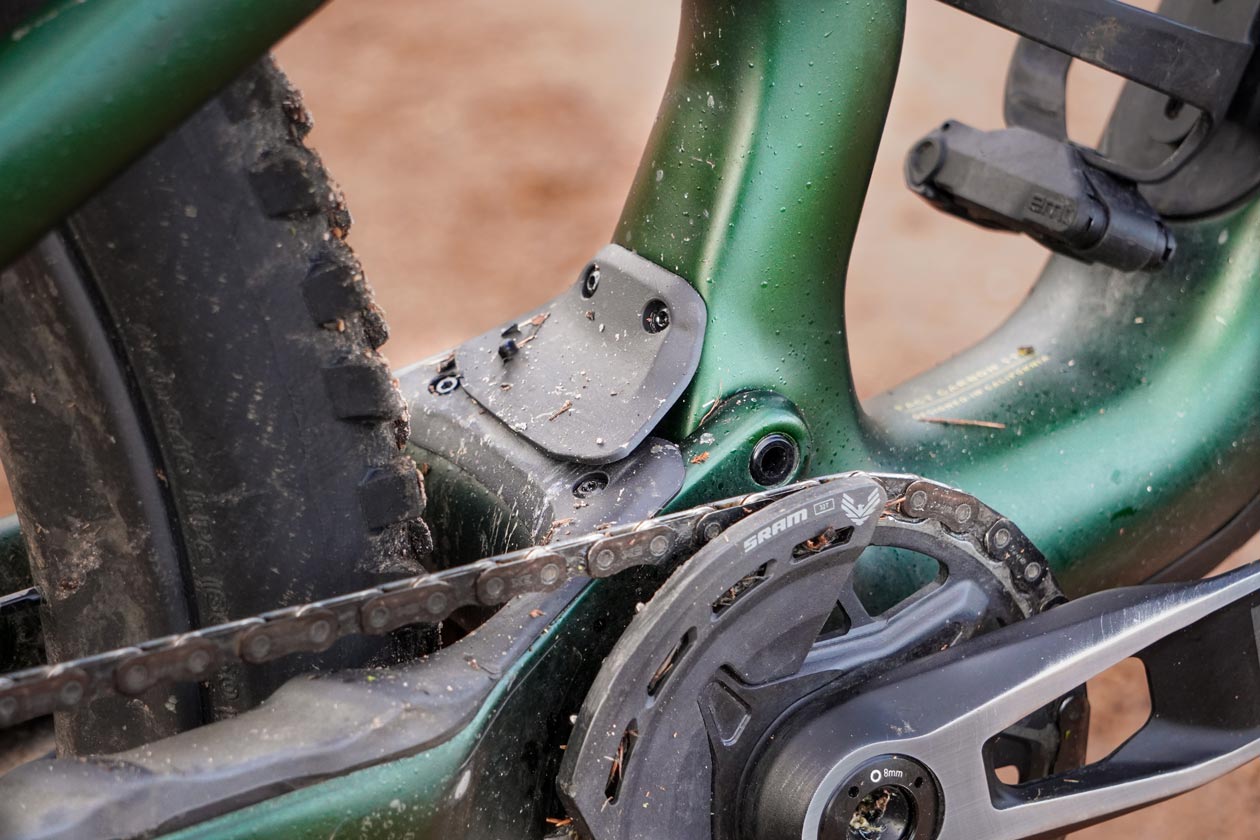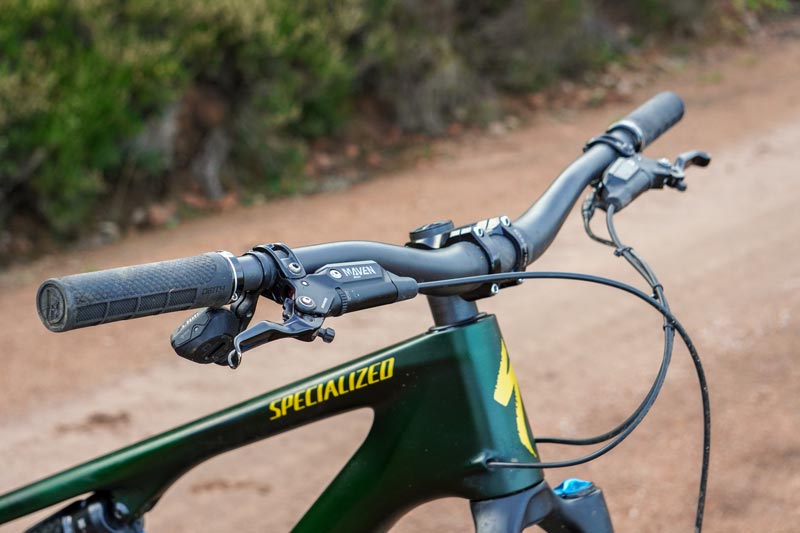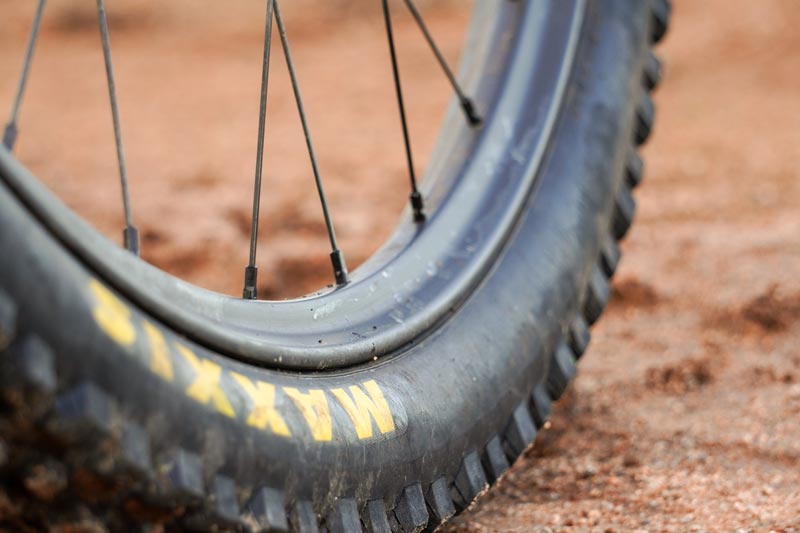ABOUT THE SPECIALIZED STUMPJUMPER 15
FRAME AND FEATURES
The Stumpjumper 15 Pro is the latest offering from Specialized in the Stumpjumper lineage. It has some new features and a move away from the side brace frame design of the previous model. Additionally, there are no longer the regular and EVO models, as the line up has been simplified.
All carbon frames are manufactured from Specialized’s FACT 11M carbon fiber, and the S-Works models get an upgraded carbon fiber linkage. Specialized also offers a selection of cheaper alloy-frame Stumpjumper 15s. All frames come UDH-equipped and T-Type compatible, with internal routing for the brake hose and dropper post cable
Specialized has tailored their sizing in an attempt to meet the needs of a wide range of riders. The bike is offered in S1 to suit riders from 150cm tall right up to S6 for riders around the 200cm height. S1 and S2 are supplied in the MX format, with the remaining S3-S6 rolling on full 29”. Specialized offers a link to convert the larger sizes into a mullet, but this does not come with the bike.
The S1 size comes with a size-specific fork at 140mm travel, and the remaining sizes are provided with 150mm of front travel. The chainstay lengths incrementally increase with the frame sizes. The handy SWAT storage system combines their SWAT box in the downtube with a bottle holder equipped with an easily accessible multi-tool. The frame is provided with a good level of downtube protection and a neat mud flap covering the main suspension pivot. Effective chain slap protection rounds out the factory provided protection and contributes to a dialed overall package.
The head angle can be tweaked by owners via the removable headtube cups, giving 1-degree adjustment either way from the standard 64.5-degree headtube angle. In addition to this, the Horst Link pivot on the chainstay has a flip chip that drops the BB height by 7mm; increases the chainstay length by 6mm, and slackens the head angle a further 0.5 degrees when set to the low position. Rounding off the frame features is a very welcome 73mm threaded bottom bracket. Owners will now benefit from a lifetime frame and Roval wheel warranty, along with lifetime pivot bearing replacement.
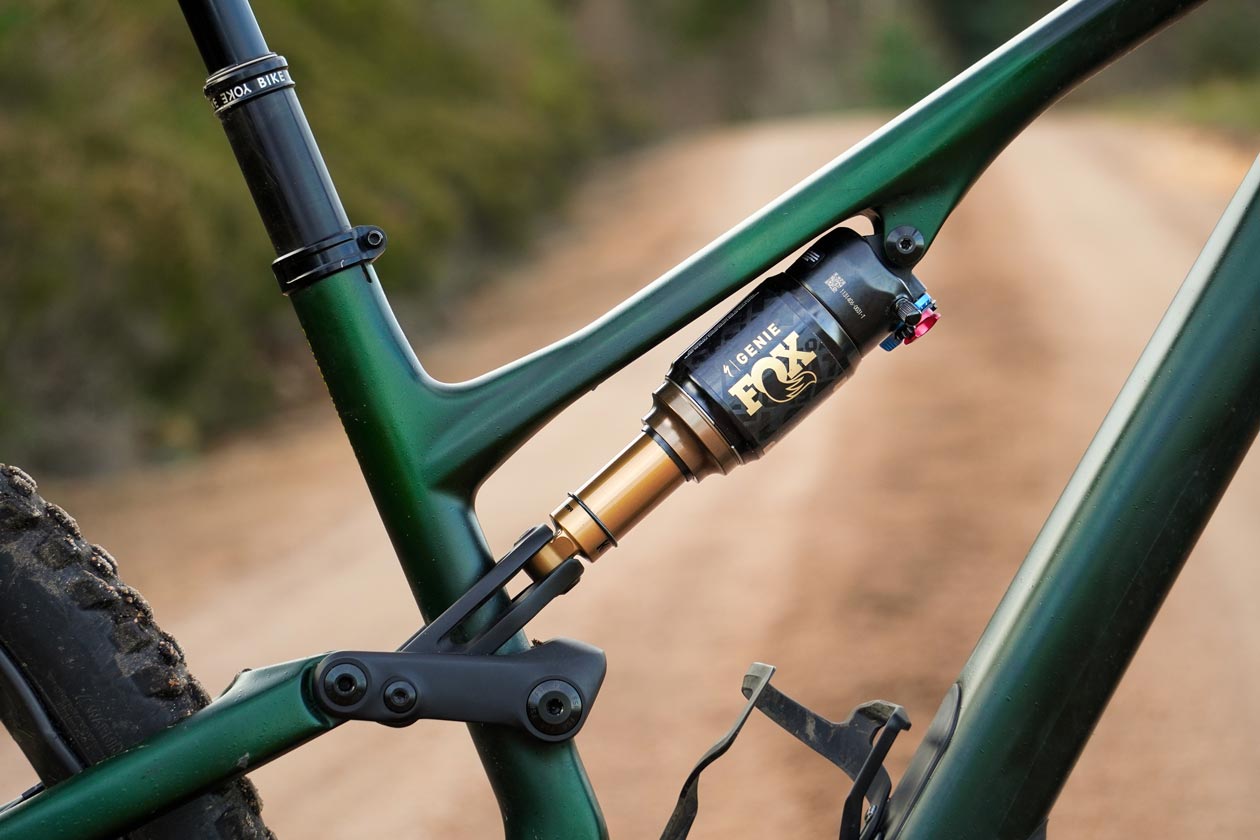
SUSPENSION
The front of the Stumpjumper 15 features 150mm travel as standard, aside from the 160mm fork on the coil-sprung, mixed-wheel models. The 145mm of rear wheel travel is controlled by a Fox Float factory shock, with Specialized’s new Genie technology. The exception is the S1, which has a shorter 140mm rear travel with a 140mm fork to match.
The showpiece for the Genie shock is the air spring system. It utilizes two positive air chambers connected to each other via ports which are closed off as the shock moves past 70% of travel. This provides a larger volume of air at the start of travel for a supple ride, which then reduces as the connecting ports are closed off to provide increased progression in the shock. The outer air chamber can have Genie Bands added to adjust the air spring characteristics in the initial portion of the travel, and the inner chamber can be tweaked with volume spacers to adjust the amount of ramp-up at the end stroke.
The Genie Factory shock features the same adjustments as a standard Float Factory shock, with a 2-position compression lever to select between open compression and climb mode; 3 low-speed compression options in the open setting, and rebound speed adjustment.
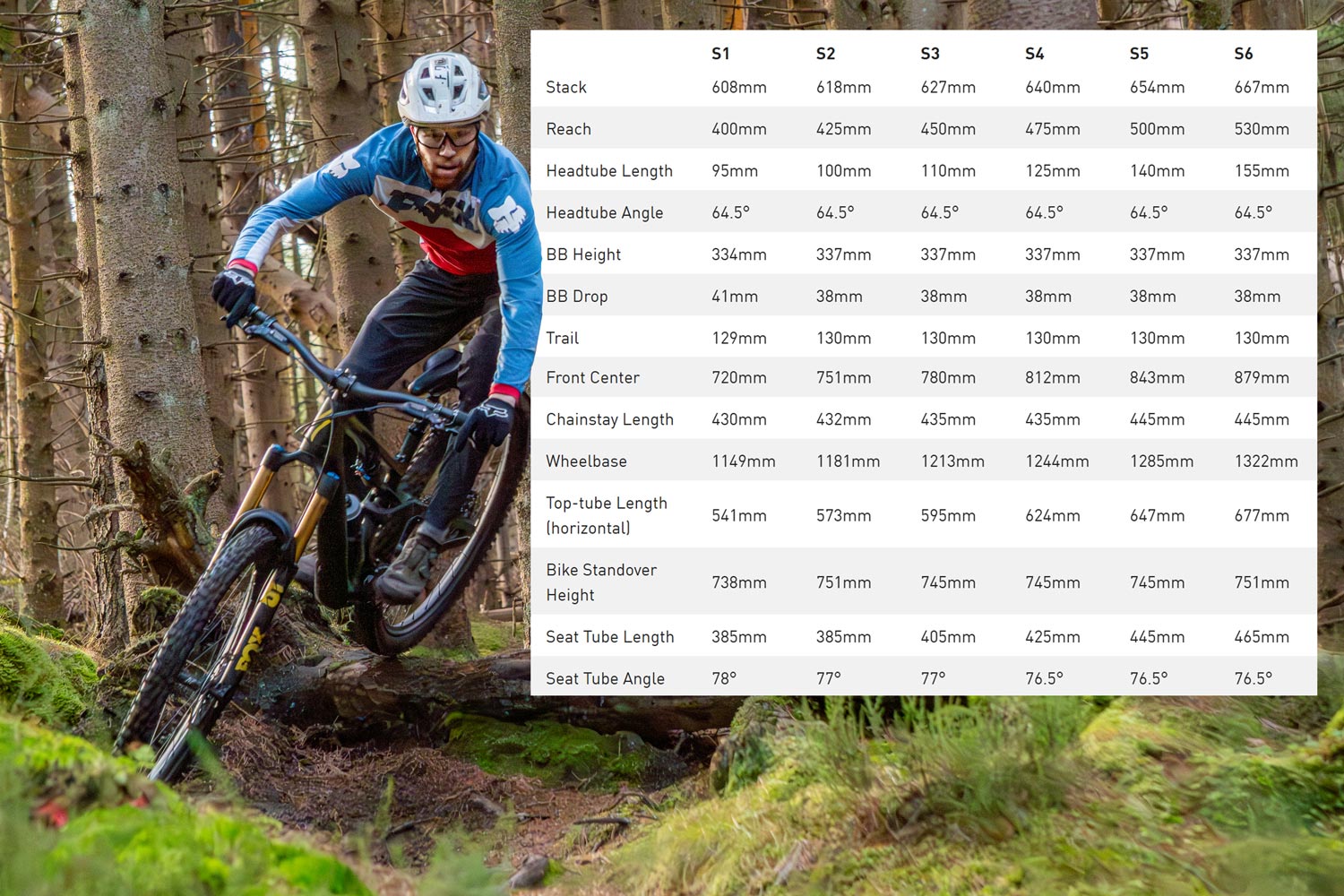
GEOMETRY
Specialized has made some small tweaks to the geometry without pushing towards the extreme end of the sizing, allowing for the bike to feel at home straight away regardless of the flip chip settings. The S4 size on test featured a Reach of 475mm and a fairly tall Stack height of 640mm.
Running the chainstay flip chip in the slack position gave a very nice “sat in” feeling at the BB, while maintaining a good stance for nimble handling. The 76.5 seat tube angle was efficient for climbing but didn’t feel too steep or over the front. The total adjustability of the bike was impressive without becoming overwhelming. This gives the opportunity for riders to make meaningful changes without ending up completely baffled or reaching a setting that is too unbalanced in any area.
BUILD SPECS
Specialized offers the Stumpjumper 15 in a wide range of build specs, from the entry-level Comp Alloy at $4,500 / £3,750 to the top-spec S-Works LTD build decked out in Fox Factory NEO suspension and dropper post at $13,500 / £11,000. They also offer the Stumpjumper 15 S-Works carbon frame only option with Fox Factory Float GENIE shock at $3,500/£4,000, or alloy frame with Fox Performance GENIE at $2,300.
We tested the Specialized Stumpjumper 15 in the Pro build spec, which retails for $8,999 / £7,500, and features a components list full of high-spec parts that all but the most discerning riders are likely to be pleased with.
The suspension is Factory-level Fox, with the 36 Grip X2 up front paired to the Float X Genie shock. The drivetrain is full SRAM X0, with the Transmission AXS derailleur and shifter; X0 alloy crank and 10-52T cassette. The SRAM Maven Silver brakes stop on a pair of 200mm rotors.
Specialized’s in-house components are used for the rims, tires, handlebars and saddle. The Roval Traverse SL II rims are laced to Industry 9 1/1 hubs, and wrapped in a Specialized Butcher and Eliminator GRID TRAIL tire combo. An Industry 9 Mountain stem holds a Roval Traverse SL Carbon bar in place. And finally, a Bike Yoke Revive MAX dropper post is topped with a Specialized Bridge Expert with MIMIC saddle.
Specialized claims the S4 in the Stumpjumper 15 Pro spec to weigh 14kg (30.9lbs).
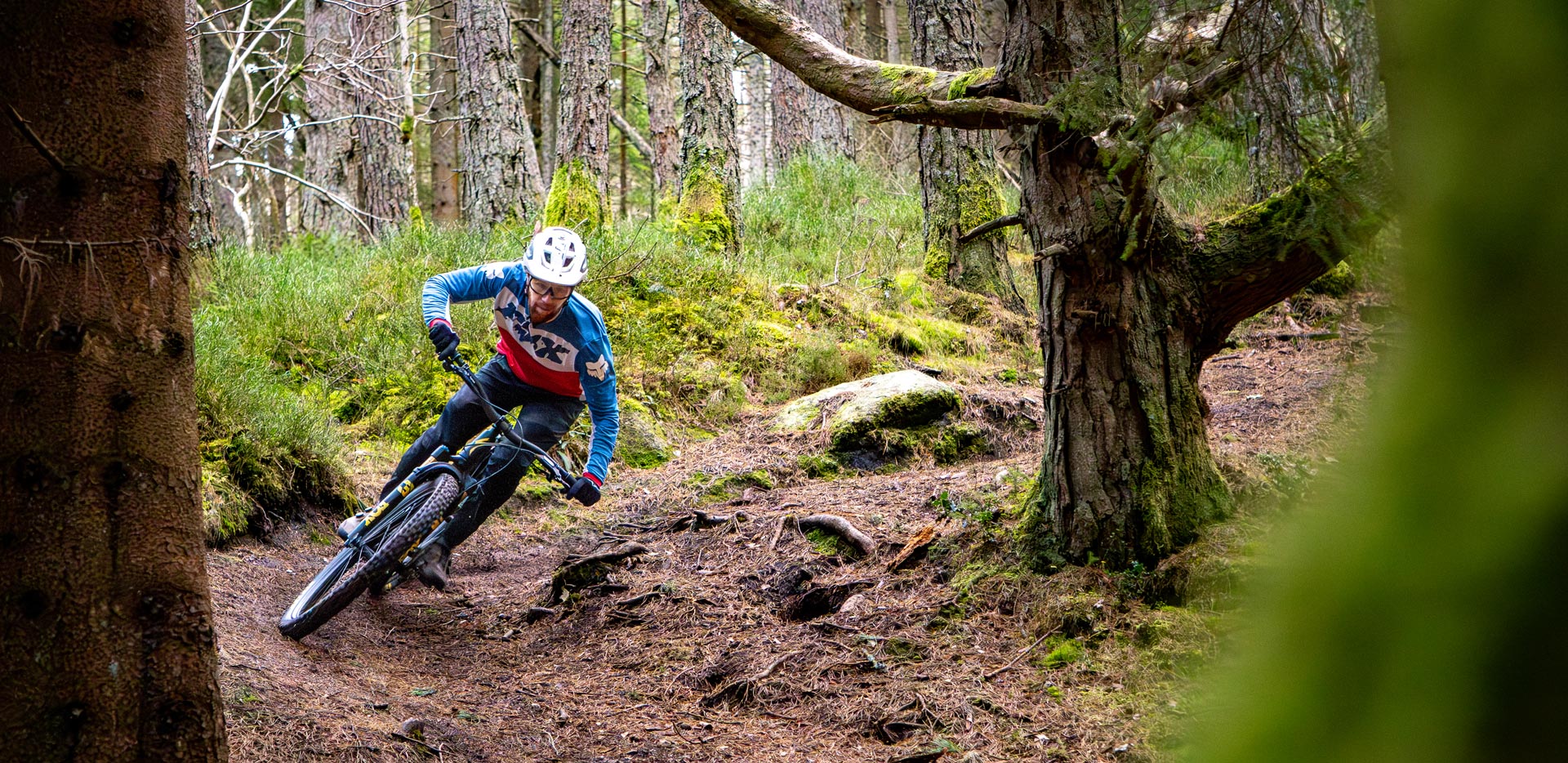
THE DIRT
For this long-term review, we decided to give a friend of The Loam Wolf, Calum Ross, the Stumpjumper 15 in a bid to put a serious amount of trail time on it and see how his impartial findings compared to mine (Robert). Following months of abuse by Calum, we got his take on the Stumpy 15’s performance, and found great pleasure in it aligning almost perfectly with Robert’s take.
SETUP
For Calum’s 178cm (5’10”) height and 75kg (165lbs) kitted weight, the S4 on test felt nearly tailor made. Similarly, Robert’s short torso and preference for shorter bikes meant that the S4 was a comfortable fit too. With the rear shock set to 30% sag and the fork at the factory base settings for each rider, the stance was one with a confident “in the bike” feel. This feeling was delivered without negatively affecting the nimbleness expected from a trail bike.
The base settings recommended for the Fox 36 provided a great starting point. We both ended up running with a slightly higher air pressure to help the front hold up, and opted for 2 volume tokens to match the bottom out resistance of the rear end. As the winter conditions hit, Calum needed to open up the rebound settings as temperatures dropped below 5°C. This is not a big deal, but some other forks are not so susceptible to this.
The rear shock took some fettling to get the most return from its adjustability. We tested from no tokens to 3 incrementally, all requiring a slightly different air pressure and rebound setting. It is worth noting that we never found any settings on the shock to feel “bad” provided they were set to 30% sag. However, the GENIE bands change the suspension characteristics considerably, so it is worth taking the time to test this out.
We had to run the rebound damping more open than typical. It never hindered the riding but was an oddity worth noting: if you’re running even less pressure than Calum’s 160psi, you might have to run it very close to or fully open.
Despite taking time to work on the shock, in its stock setup we found the bike to be a great performer early on without needing to change a horde of parts. It immediately provided confidence to push hard, meaning we could start working on the finer details of the tuning and tickling the Stumpjumper 15’s limits.
Although we enjoyed the sharp handling of the Stumpjumper 15 in the high setting, the lower BB and slacker head angle of the low setting provided a more “in the bike” feeling, which assisted when riding on more rugged technical descents. We opted to run the bike in the low flip chip setting with neutral headset cup for the remainder of the test following initial experimentation, which delivered a great balanced handling characteristic for a wide variety of trails.
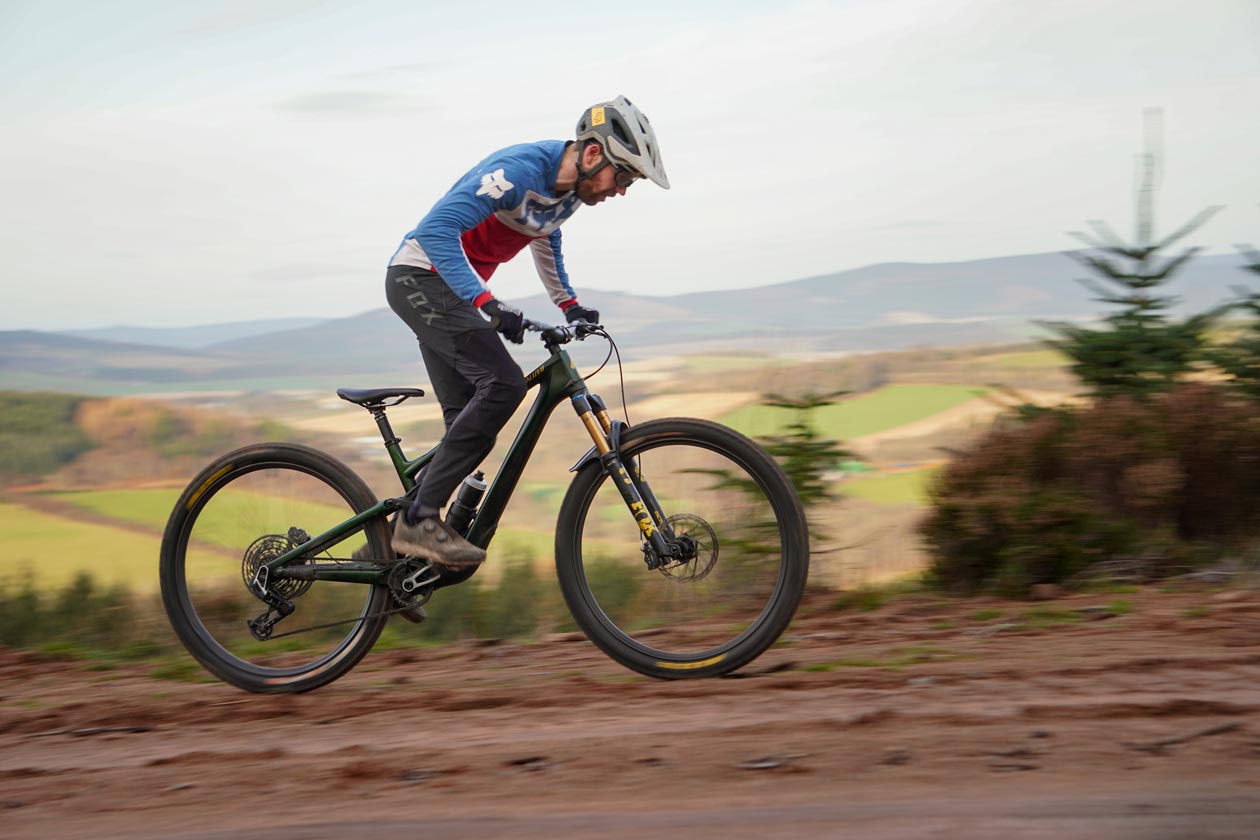
CLIMBING
The two standout features of the Specialized Stumpjumper 15’s climbing characteristics were its comfortable fit and technical climbing prowess. For the day-to-day fire road climbs, the bike was effective at covering distance at a reasonable pace. It was not more efficient than other trail bikes, however when paired with the comfort the bike provided, we found it flattered the rider’s fitness and allowed us to power through bigger days. We normally tackle smoother climbs with the climb switch engaged to maximize efficiency, since the rear end is fairly active when the shock is open.
On the steep and technical climbs easily accessed across Scotland, the Stumpjumper 15 excelled. We managed to clean climbs where other trail bikes become stuck due to their lack of all-out grip. Similarly, the Stumpjumper 15 didn’t suffer from the drawbacks of the higher weight and reduced efficiency of a full-on enduro bike. The Stumpy’s quality in this terrain was beyond encouraging, willing you to try steeper climbs rather than ditching early and opting to walk. The bike utilized a 34-tooth chainring, so you may benefit from a 32-tooth ring for the steepest climbs, to unlock its true uphill potential.
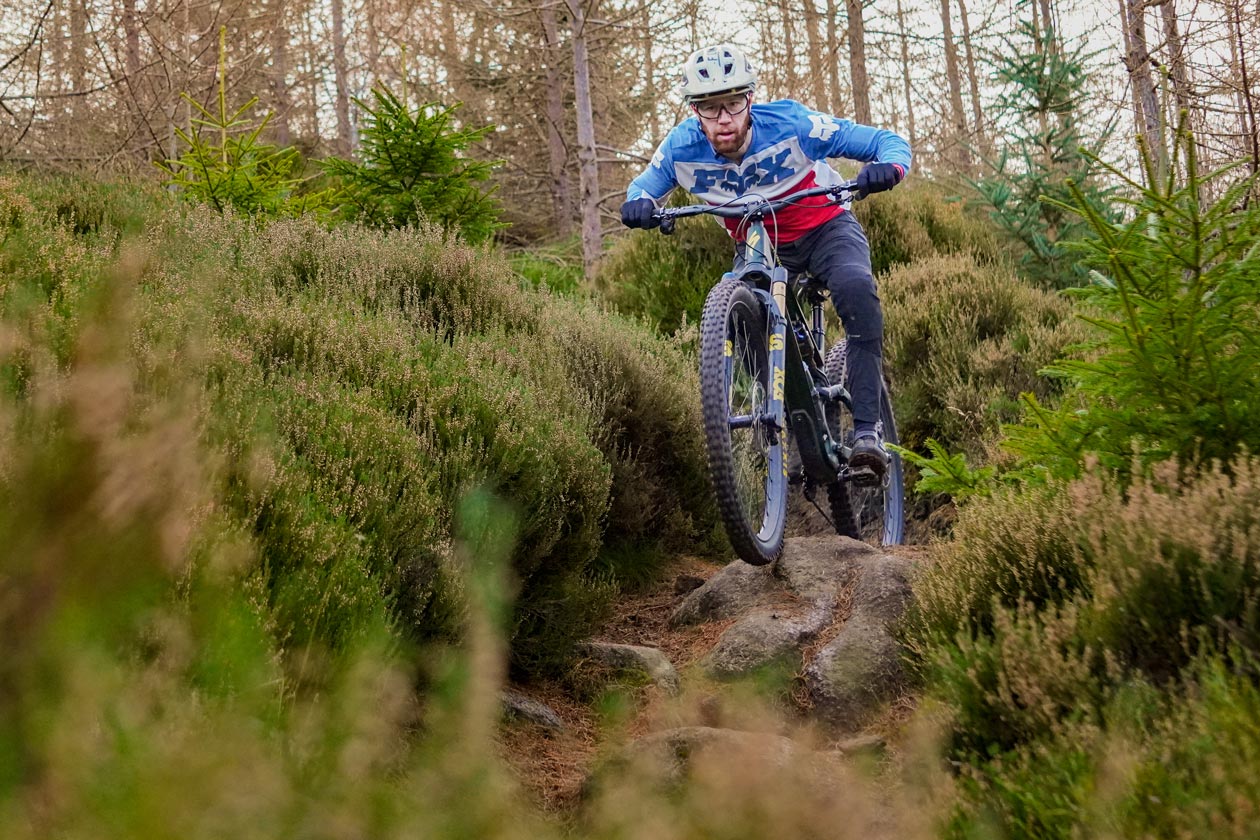
DESCENDING
“Should I buy a Trail bike or enduro bike?” is the endless, unanswerable modern mountain biker question. The descending performance of the Specialized Stumpjumper 15 Pro made an exceptionally strong case for a trail bike to do it all. As expected for a modern trail bike, it rocketed down trail center descents and mellow flow tracks without even getting into its stride. When leveling up from flow trails to large jump lines, the Stumpjumper 15 was still unflinching. The balance of the bike in the air was very even, aiding in its maneuverable nature. Thanks to an adequately supportive suspension platform, speed for jumps was easily generated. On Calum’s second ride on the bike, he found himself flying off the biggest and most technical jump line of his summer, strongly testifying to the bike’s confidence inspiring ride with minimal setup time.
After a few rides on the bike, it became apparent that the standard tires fitted were too flexible and under-protected to match the capabilities of the rest of the build. Additionally, we found them to have a sharp edge profile on the tread, which gave a “knife edge” feeling when leaning into high-speed turns, with an unpredictable turn-in. They were swapped for a burlier set of Maxxis Assegai tires, with the EXO+ up front and a Double Down rear. This seemed a fair compromise between preserving some of the Stumpjumpers’ trail bike nature but were burly enough to release much more descending potential.
Once some more suitable rubber was fitted, it was easy to enjoy some of the Stumpjumper 15’s great characteristics. Thanks to its low weight, powerful brakes, and the impressive grip from its supple suspension, the Stumpy rewarded confident, late braking. The 145mm of rear wheel travel felt surprisingly active on initial braking into corners, and we found the bike to be very poised and dynamic throughout the turns. It never felt awkward or pitched in a strange manner, helping you to maintain good body position in most turns. Many other short travel bikes require an earlier and smoother braking strategy into corners to avoid being outbraked, whereas the Stumpjumper could be ridden more like an enduro bike. Little compromise was felt in rough braking zones, with the added bonus of being able to twist and fly through tighter and more technical corners and features thanks to its nimble nature.
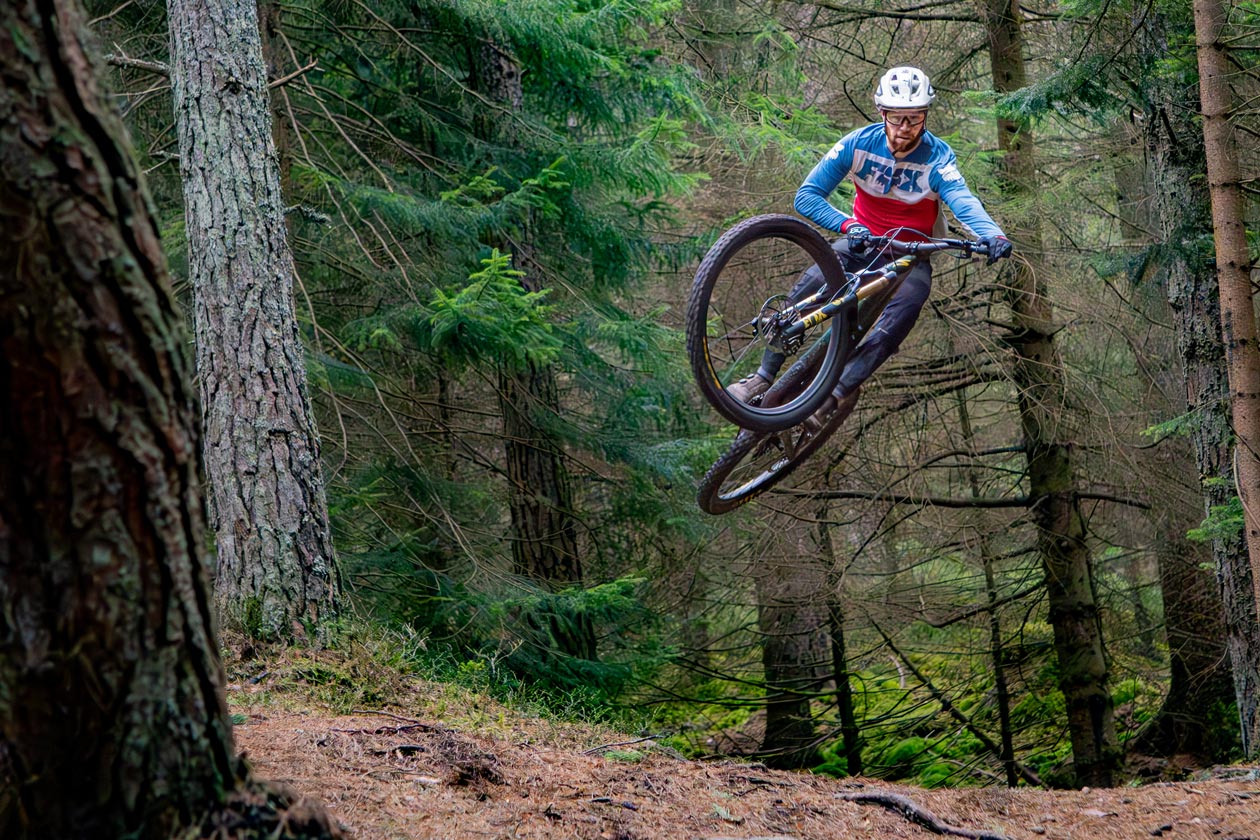
On the rougher sections of trail, Specialized managed to deliver the riding characteristics of a bike with much more travel, no doubt thanks in part to the Fox Float GENIE rear shock. The Fox 36 was easily set up to prevent too much out-of-shape pitching but never felt excessively harsh during the initial stroke. The rear suspension performed similarly over the bumps, and as such we never found the Stumpy to suffer from the fore and aft pitching that can be very off-putting when riding some smaller travel machines in gnarly terrain. The small bump compliance was fantastic, and to our surprise straight line chunk and rock gardens were not a problem at all, as the bike maintained good composure even when deep into the travel.
It was not until trail speeds became very high that the bump compliance of the suspension and general stability started to come into question. Even at this point, other aspects of the bike could be improved first to give an even greater bump swallowing feel. When pushed very hard, the front end suffered from a deflecting feeling when hitting angled bumps or non-uniform rocks at high speeds. This induced a sideways kick sensation at the front that reduced the chances of suspension reacting to the angled forces. It was only happening on very rough technical tracks being tackled at full effort, where a true Enduro bike would be much more suitable. The issue could have been helped firstly with a heavier tire casing, but to further improve it an alloy wheel could allow the front end to track the terrain better. These aspects would be worth considering for a rider to truly maximize the Stumpjumper 15’s potential, but for the most part it did an absolutely stellar job as it was.
These changes start to lead down the path of building a trail bike into an enduro bike and would undoubtedly detract from some of the Stumpjumper 15’s other great characteristics. The only characteristic we actively disliked with the stock build was the tendency for the rear suspension to compress deep into the travel during low-speed compression situations, such as the bottom of rock rolls and during big berm G-outs. This occasionally produced a rearward pitching sensation. This could be countered with more air pressure, but at the expense of bump performance, so it would have been nice to see more Low-speed compression adjustment range on the shock considering the adjustability already on offer.
Ultimately the Specialized Stumpjumper 15 could be ridden down any trail as fast – and often faster – than a full-blown enduro rig. It only lost out on the roughest high-speed sections and hard G-out features. But thanks to its fast acceleration and fluid cornering, a very high average speed could be maintained across all the test tracks with a rewarding trail experience.
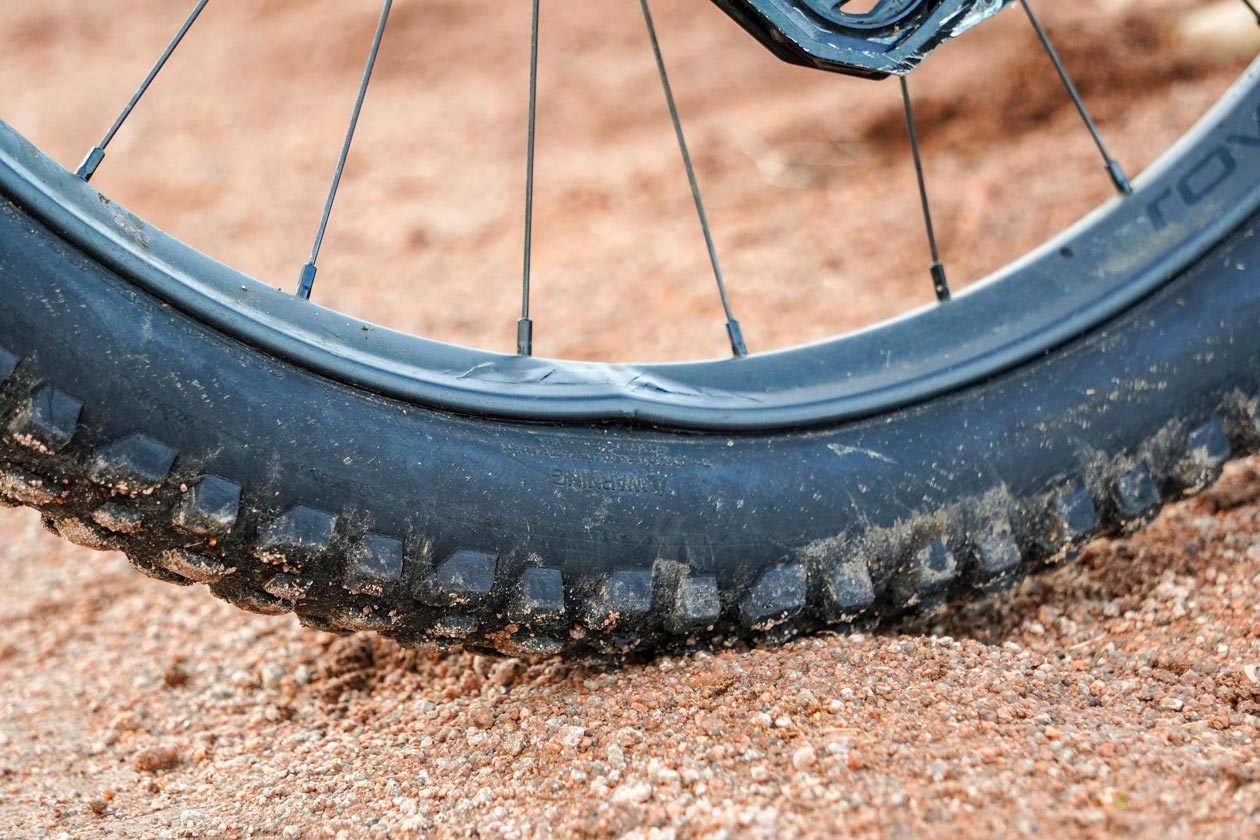
COMPONENT REPORT
Fox Float GENIE Shock – We didn’t have the opportunity to test the Stumpjumper 15 with an alternative shock. However, the kinematics are not much departed from the previous generation frame, so it’s safe to assume the improved performance of the rear end can primarily be attributed to the GENIE shock.
With zero or one of the GENIE bands in this shock, its sensitivity and comfort was impressive, though support earlier in the stroke could leave a little to be desired for some. Two bands gave a more supportive character while still offering some benefits to the general comfort when compared with a standard Fox Float. Going up to three or four bands, the feeling was of a more traditional air shock, albeit with strong bottom out resistance. Being able to tune the spring curve characteristics so easily was much appreciated, letting you drastically alter the feeling of the rear end of the bike. We’d have loved to see more low speed compression tuning range to get the best out of the Fox Float GENIE, as featured on the Float X GENIE.
Roval wheels on Industry 9 Hubs – There were no hub issues during the test, running smoothly with good pickup. We managed to crack the rear carbon rim in a heavy rock strike during a race scenario. It’s hard to say that other wheels would have held up in the same situation, as the impact sustained was significant. Although the rim lost the ability to seal tubeless, impressively it held up to over 10 rides with a tube fitted following the damage.
SRAM Maven Silver Brakes – We have already documented our thoughts on the SRAM Maven brakes in detail. On this test, we found nothing to contradict our previous findings. The heavy initial lever pull can be fatigue inducing on long descents, and hinders the bike’s descending potential in certain scenarios. Once engaged though, the Maven is extremely powerful, especially on such a light bike. Calum found it could be hard to obtain the exact braking power desired, as the bite was somewhat vague in feeling. A new issue cropped up midway through testing, with the lever bearing moving in the housing, leading to the lever catching on the master cylinder. Attempting to be positive, the HS2 rotors at 200mm are a nice choice and held up well during the test coming out the other side with no bends, buckles or heat issues.
Bike Yoke Revive Max Dropper Post – The BikeYoke Revive dropper seatpost has typically been a solid performer, with smooth and dependable performance across countless units we’ve had on previous test bikes. This particular unit developed some play after around 300 miles of our testing. It was noticeable when climbing with the shock locked out, but hard to perceive otherwise. It’s possible that it could be remedied with a good service, but it seemed a bit premature in the post’s life to develop this.

HOW DOES IT COMPARE
SPECIALIZED STUMPJUMPER 15 VS YT JEFFSY
How does the Stumpjumper 15 compare to some of its most direct competition in the form of the recently reviewed YT Jeffsy? On paper the pair have many similarities, but each bike definitely has a distinct feel and would suit different end users.
On paper the geometry of both bikes is very close, but Calum found the Specialized to be a better fit for his 178cm height and average limb length build. The Jeffsy felt more stretched out when climbing and descending, likely due to its stock 50mm stem spec. Comparing both bikes in the large sizes (L and S4) the Jeffsy would suit taller riders or anyone preferring an extra spacious feel.
Climbing on both bikes feels very efficient, but Calum preferred the firm feeling of the Jeffsy when tackling long smooth fire track climbs or any climb with technical features. However, for the steepest or most technical climbs the Stumpjumper had to edge, feeling easier to change line and providing increased grip.
Unsurprisingly the descending characteristics somewhat mimic the climbing ones. The Jeffsy felt responsive and firm, which was rewarding when riding trail center or bike park trails where the terrain was not as aggressive. As the terrain became more advanced and rougher, the Stumpy had the edge. It was able to scrub off speed in a more aggressive fashion in rugged braking zones. When descending high-speed trails with larger natural features, it had noticeably less front and rear pitching and better repeat bump performance. This also led the rider to being less fatigued when taking on longer runs. Both bikes handled the daunting terrain of this nature well given their travel numbers and intended use, with each having potential for upgrades to easily improve their proficiency on these trails. Straight out of the box though, the Specialized allowed for notably harder charging.
Matching a like-for-like spec at the highest level we tested of XO drivetrain and Fox factory suspension, the Jeffsy looks to offer customers a considerably less bank-bursting option. But with an added alloy option on offer from Specialized, choosing the best value from the two is not an easy job. Both bikes can be assembled differently to operate at different ends of the trail bike world. For a wallet-friendly lightweight trail center cruiser the Jeffsy is a great option, but the range of builds on offer from Specialized would make it my personal choice for handling more technical terrain. Both bikes are well finished, but the Specialized slightly edges the YT when it comes to the overall build weight and some of the smallest details. Ultimately with the range of abilities capable from both bikes, take time to consider your main use and priorities before choosing your bike and build. Both are ready to rally.
The Wolf’s Last Word
Specialized has once again elevated the performance of their Stumpjumper platform, offering increased capability without significant detriment to its trail-friendliness. The Stumpjumper 15 can be taken from a mild-mannered trail machine through to a light enduro ripper, thanks to excellent adaptability through a combination of highly adjustable geometry and the tuning potential offered by the Fox Float GENIE rear shock.
The Specialized Stumpjumper 15 truly has the potential to truly be a “one bike for everything”, with some small part changes taking it from a mile-cruncher to an enduro ready machine in combination with the inbuilt adjustability. With a high-quality finish, solid warranty, and excellent performance, it’s safe to say Specialized is still setting the trail mountain bike benchmark with their Stumpjumper 15. ![]()
Price: $8,999 (As Tested)
Website: Specialized.com
SHARE THIS REVIEW
SUPPORT AND JOIN THE LOAM WOLF PACK
Did you find this review helpful? Would you like the chance to review (and keep) products? Are you interested in saving big bucks by getting exclusive Members Only discounts from industry brands all while helping support a small, rider-owned media crew? We have big plans for our members beyond big discounts and product giveaways! To learn more and help support small, independent media, visit our Member’s Page.




